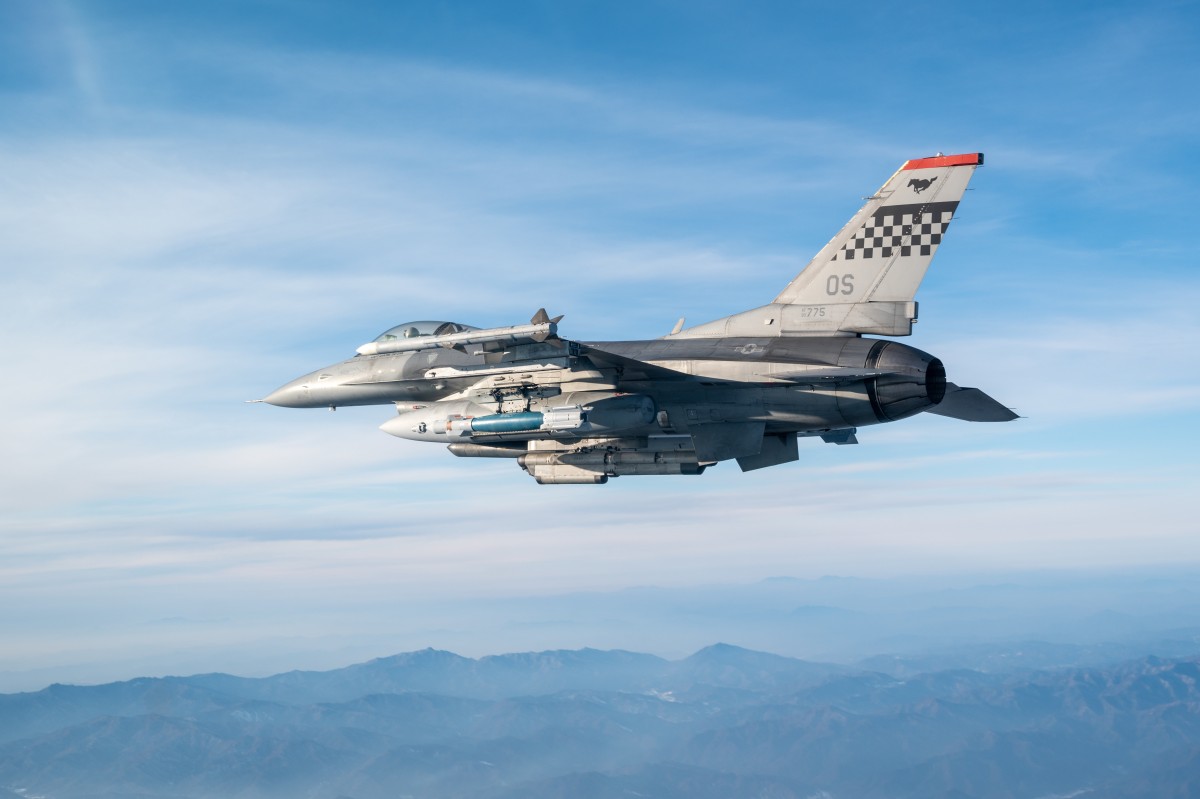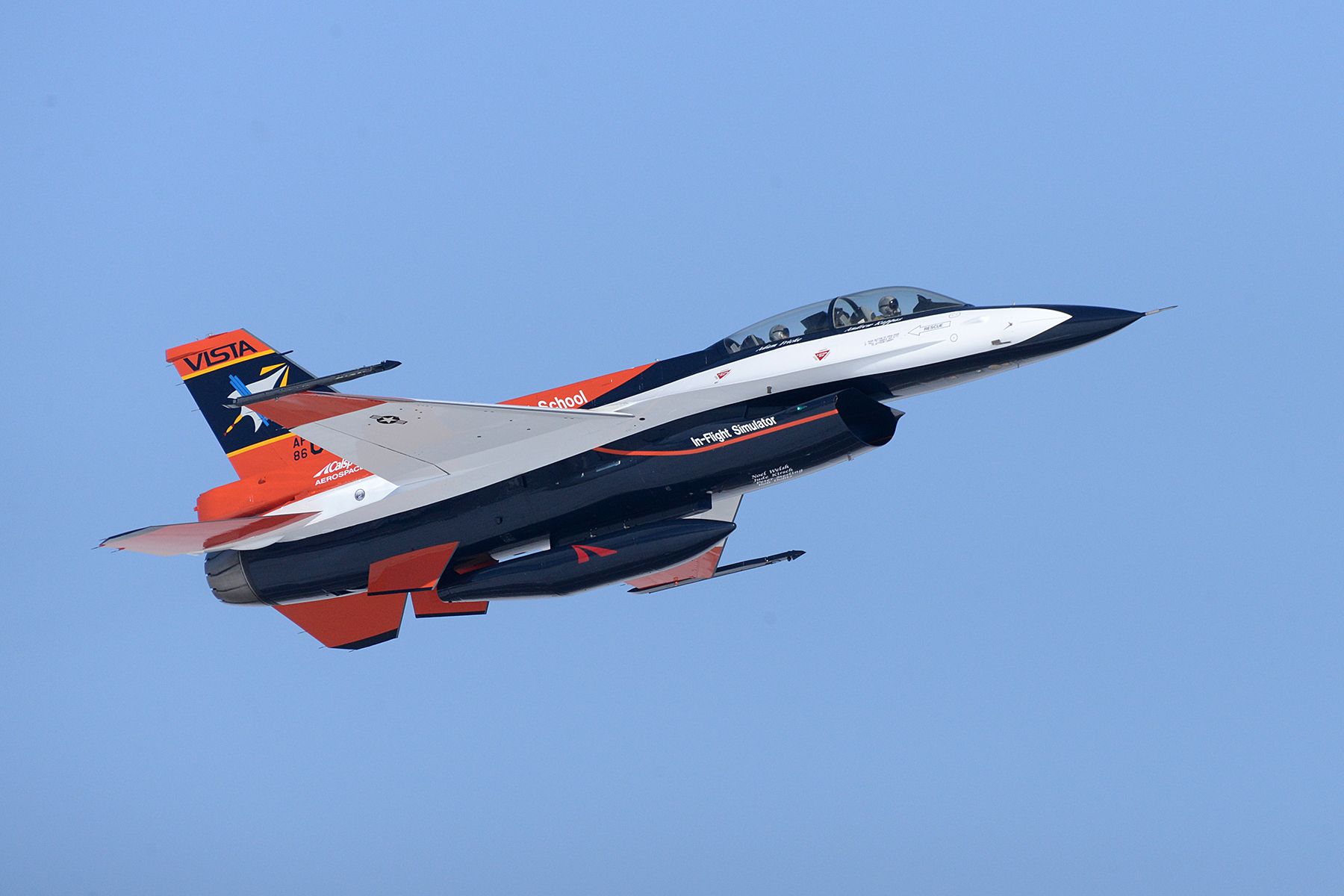The United States Air Force (USAF) and the Defense Advanced Research Projects Agency (DARPA) conducted a dogfight between an Artificial Intelligence (AI)-controlled fighter jet and a manned fighter.
DARPA disclosed earlier this week that during a test conducted at the Edwards Air Base in September last year, an X-62A VISTA aircraft, a modified F-16 fighter used for testing and training AI software, engaged in a duel against a human pilot in another F-16.
Air Force officials informed reporters the successful attempt to have the X-62A VISTA participate in aerial combat training could assist the service in improving its plans for collaborative combat aircraft or autonomous drone wingmen which are expected to play a very significant role in future combat.
For the past four years, DARPA has been working on the Air Combat Evolution, or ACE, initiative, which aims to improve the military’s use of artificial intelligence (AI) in air warfare and increase airmen’s confidence in the reliable and safe operation of autonomous equipment.
Lockheed Martin Skunk Works, in association with Calspan Corporation, created a unique training aircraft, VISTA. It is equipped with software that enables it to replicate the performance characteristics of other aircraft, including flight control capabilities. It was built on an open systems design.
The program has progressed at an incredible rate since its launch. For instance, it was only in December 2022 that a modified F-16 fighter jet completed an Artificial Intelligence-controlled test flight for the first time in history. At the time, the aircraft was reportedly flown by an artificial intelligence agent for more than 17 hours, representing the first time AI was engaged in a tactical aircraft.
A release published by the agency said, “The flights demonstrated that AI agents can control a full-scale fighter jet and provided invaluable live-flight data.” Since it was constructed in December 2022, the X-62A has flown on at least 21 test flights.
Less than a year after this autonomous flight, the AI-driven fighter jet had squared off against a manned F-16 in what appears to be a massive feat for the USAF.
Until now, the military has only employed autonomy in areas of flight that are known and predictable, like the Auto Ground Collision Avoidance System, which enhances safety by mitigating controlled flight into terrain accidents for aircraft like the F-35.
Pentagon conducts first-ever air battle between human and AI
The U.S. Department of Defense's Office of Advanced Research Projects conducted a training air battle between an X-62A robotic fighter jet and a human-piloted F-16 fighter jet.
Which side won is not reported. pic.twitter.com/GsHhQY6W0s
— NEXTA (@nexta_tv) April 19, 2024
Col. James Valpiani, commander of the Air Force Test Pilot School, noted that AI would need to acquire a completely new set of abilities for within-visual range dogfighting, which is arguably the riskiest and most unpredictable type of flying a pilot can partake in.
“Dogfighting presents a very important challenge case for the question of trust” in autonomy, Valpiani said. “It’s inherently very dangerous. It’s one of the most difficult competencies that military aviators must master.”
Due to national security considerations, the US military will not reveal the outcome of this real-world combat between a manned plane and an artificial intelligence-controlled F-16. However, speculation is rife that the AI fighter jet may have secured a historic win.
Some reports referred to the August 2020 showdown between an AI-controlled fighter and a fighter pilot in a simulated combat. AI defeated a human operator 5-0 in a simulated dogfight and did not allow the human pilot to score a hit. At the time, officials said that the results weren’t particularly shocking because the combat was not entirely realistic.

Earlier, it was contended that the AI system was functioning in a battle setting for which it was trained and that it seemed to have access to knowledge that it would not have in the real world.
It resembled a computer game more than a real air battle, with actual planes competing against one another. The AI would have “crashed and burned” in a genuine battle, they said. However, technology has advanced since then.
In 2021, reports surfaced that the Chinese PLA Central Theater Command Air Force simulated a dogfight in which a highly experienced pilot was shot down by an artificial intelligence (AI)- driven aircraft. However, that was also a simulated training exercise.
The US real-world dogfight appears to be a first and a very different ballgame as compared to a video game-like simulated combat.
The USAF Is Vested In VISTA
The Air Force and DARPA began real flight testing with AI agents operating VISTA between December 2022 and April 2023. And in September 2023, VISTA was ready to face off against a human pilot.
VISTA flew against an F-16 over two weeks in a range of circumstances, including ones in which it was initially at a disadvantage against the plane flown by a human pilot.
Before launching into ferocious attacking maneuvers, VISTA began its flight with defensive maneuvers to increase trust in its flight safety. According to Valpiani, the jets engaged in aggressive flying, making nose-to-nose passes and vertical maneuvers while traveling at up to 1,200 miles per hour and staying within 2,000 feet of each other.
Two pilots manned VISTA’s cockpit, switching between AI agents to assess each one’s performance and monitor the systems. They were never required to take control of the aircraft. VISTA conducted 21 test flights between December 2022 and September 2023.
Col. James Valpiani stated that the AI agents aboard the planes were able to be changed or improved during a mission, which likely made air combat more difficult for the opposition.

“We were able to generate software changes overnight,” he explained, adding that “we were able to upload the software changes to the aircraft while it was holding short, ready to take off and even airborne.” He said that “we’re able to transition between multiple versions of the same AI agent airborne, between combat sets.”
According to Valpiani and Lt. Col. Ryan Hefron, DARPA’s ACE program manager, the AI-flown VISTA operated well and tested a range of agents with various capabilities. However, they would not specify how many times VISTA outperformed the F-16 flown by humans. “The purpose of the test was to demonstrate we can safely test these AI agents in a safety-critical air combat environment,” Hefron said.
According to Hefron, the program will next host more VISTA versus F-16 games to hone the technology and try out various scenarios.
They claimed that the lessons acquired from ACE had other applications outside of dogfighting. With the help of ACE, the service will be able to develop unmanned CCAs capable of conducting airstrikes and surveillance missions while flying autonomously alongside crewed fighters like F-35s and the Next-Generation Air Dominance platform.
The USAF’s interest and commitment to the AI-piloted jets was demonstrated recently when Air Force Secretary Frank Kendall announced that he would take a flight in the self-piloting aircraft later this year to witness the AI algorithms at work firsthand.
According to Valpiani, Kendall’s flight in the X-62 would be “a strong indication that the work that we’re doing here directly feeds into and helps advance the collaborative combat aircraft effort.”
- Contact the author at sakshi.tiwari9555 (at) gmail.com
- Follow EurAsian Times on Google News




